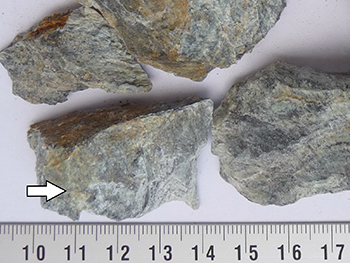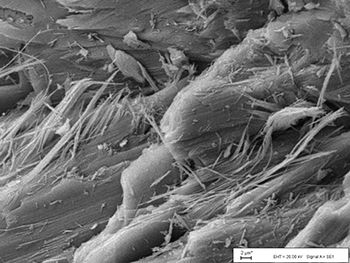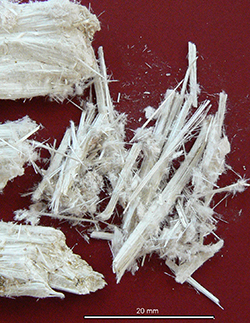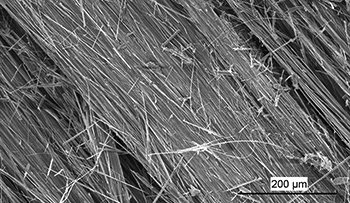John Keeling
Geological Survey of South Australia
Download this article as a PDF (3.9 MB); cite as MESA Journal 86, pages 45–48
Figure 1 Southern portal Kirchdorf tunnel S35 expressway. (Courtesy of Austria-Forum)
During 2006 to 2009, excavation of the Kirchdorf tunnel on the Bruck Expressway S35, Austria, encountered high volumes of airborne asbestos fibres, far in excess of that predicted from preliminary site geotechnical and environmental surveys (Fig. 1). The mystery of why the hazard went undetected was solved recently by researchers Drs Walter Vortisch (Montanuniversität Leoben) and Xaver Baur (Freie Universität Berlin) using knowledge gained from Geological Survey of South Australia (GSSA) investigations of an unusual asbestos occurrence near Rowland Flat, 50 km northeast of Adelaide (Keeling et al. 2008). In a paper published in November 2017, in journal BHM (Berg- und Hüttenmännische Monatshefte), Vortisch and Baur concluded that the fibres in the Kirchdorf tunnel were an asbestiform variety of the mineral antigorite, which is unregulated as an asbestos mineral in Germany (Vortisch and Baur 2017). Asbestiform antigorite is not universally recognised, but was identified, in 2005, from a historic small quarry operation near Rowland Flat, which previously supplied mixed asbestos-talc product for use as an industrial fibrous filler (Keeling, Raven and McClure 2006). Small-scale production from the Rowland Flat quarry ceased in 1978. The significance of the Austrian study, particularly for European environmental regulation, was recognised by acceptance of the paper for publication in both the industry journal BHM and international mineralogical journal Neues Jahrbuch für Mineralogie (Vortisch and Baur 2017, 2018).
Internationally, asbestos regulation has been developed around fibrous varieties of six minerals: 5 amphiboles (crocidolite – fibrous riebeckite or blue asbestos; amosite – fibrous cummingtonite/grunerite or brown asbestos; anthophyllite asbestos; tremolite asbestos; actinolite asbestos), and 1 serpentine (chrysotile – white asbestos) (e.g. Strohmeier et al. 2010). Amphibole asbestos is acknowledged as highly carcinogenic, responsible for lung fibrosis, lung cancer and mesothelioma, and by the 1980s was banned in most countries. Evidence for chrysotile as a causative agent in lung cancer, and particularly mesothelioma, remains equivocal (Bernstein et al. 2013), despite persistent links for these cancers with occupational exposure to chrysotile. Counter arguments include that the suspect chrysotile sources also contained fibrous tremolite (e.g. Bernstein 2006). Reviews of many epidemiological studies, however, showed sufficient correlation between chrysotile and disease to convince many, but not all, countries to cease using chrysotile asbestos. Importation and use of chrysotile asbestos in Australia was banned in December 2003.
Chrysotile asbestos makes up over 90% of all historic and current asbestos used worldwide. Chrysotile is widely regarded as the only common serpentine mineral that crystallises with asbestiform habit. Most abundant serpentine minerals, lizardite and antigorite, typically form as small flakes, which are considered harmless. The perception of chrysotile as the sole serpentine asbestos persists, despite early mineralogical descriptions of splintery and fibrous forms of antigorite referred to as ‘picrolite’, but discounted as forming separable fibres (Wylie 2017). The significance of the Rowland Flat study is that this was the first confirmation of antigorite with asbestiform habit mined for use as a commercial asbestos fibre (Fig. 2). Chrysotile and antigorite have the same chemical composition (Mg3Si2O5(OH)4), and distinguishing between the two fibrous forms requires careful mineralogical investigation, with appropriate spectral or X-ray diffraction techniques, used in conjunction with electron microscopy (Keeling et al. 2008). The possibility exists, therefore, that asbestiform antigorite occurs more widely but has gone unrecognised, or incorrectly identified as chrysotile. Differentiation of the two minerals is significant for the reason that the few laboratory studies available on the health effects of antigorite fibres, report carcinogenic indicators similar to those observed with amphibole asbestos (Wozniak, Wiecek and Stetkiewicz 1988; Cardile et al. 2007).
Figure 2 South Australian samples.
The Kirchdorf tunnel investigation highlights the importance of asbestos definition in relation to effective health and safety legislation and correct mineral identification. Preliminary engineering and site geological investigations identified a 500 m section of predominantly serpentinite rock, at the southern end of the 2.7 km proposed tunnel excavation. The possibility of asbestos was acknowledged, but the mineralogy of the serpentinite was determined as dominantly antigorite. No chrysotile was identified, although minor chrysotile veins were reported in similar serpentinite, in a quarry 30 km to the west (Dissauer, Präsent and Schwab 2009). Although the likelihood of encountering asbestos was considered low, guidelines and monitoring for asbestos were in place at commencement of the tunnelling operations. At 150 m into the southern excavation, serpentinite was encountered accompanied by high airborne fibre counts. Asbestos abatement was commenced with water mist arches and auxiliary extract ventilation. This approach proved to be inadequate. Airborne fibre counts of up to 1.2 million fibres per cubic metre of air continued to be recorded, compared with recommended permissible levels of <1,500 fibres per cubic metre of air (Dissauer, Präsent and Schwab 2009). The presence of talc was a complicating factor. Talc is a hydrophobic mineral that is not readily wetted. The association of talc with asbestos fibres reduced the effectiveness of water misting for dust suppression, particularly during drill and blast operations, but also with the removal and disposal of waste rock. Solutions were developed to contain the airborne fibres, and ‘forced mixing’ was used to ensure the waste rock was sufficiently wetted to enable it to be handled and transported without excessive dusting (Dissauer, Präsent and Schwab 2009). All this came at a cost and required extensive consultation and substantial modification to work practices. The disruptions delayed the project by nine months. The twin portal tunnel was successfully completed and opened to traffic in May 2010.
The assumption at the conclusion of the project was that an essentially unrecognised and unpredictable distribution of chrysotile had been encountered (Dissauer, Präsent and Schwab 2009). Walter Vortisch was not convinced, and preliminary tests on serpentine rock near the southern portal reconfirmed the dominance of antigorite, with no indication of chrysotile.
In January 2017 Vortisch contacted the Geological Survey of South Australia for information on asbestiform antigorite from Rowland Flat, and criteria for identification. The information provided was used to build the case for antigorite as the dominant serpentine asbestos encountered during excavation of the Kirchdorf tunnel. Subsequently, 28 surface samples, 17 samples from dumped excavated rock, and samples from earlier excavation sites were examined. Mineral identification was primarily by X-ray diffraction, supplemented with scanning electron microscopy. Of the 51 samples analysed, 28 were serpentinites. Of these, only 4 contained chrysotile, mostly as a minor component with antigorite, with only one of the samples showing dominant chrysotile. Gentle crushing of apparently massive serpentinite, composed essentially of pure antigorite, resulted in disaggregation and separation of fine flexible fibres (Fig. 3), with asbestiform dimensions of sub-micron width and several microns length (Vortisch and Baur 2018). This is convincing evidence that antigorite was a primary source of airborne fibres encountered during tunnel excavation.
Figure 3 Austrian samples.

Figure 3a Serpentinite samples collected from surface outcrop, 100 m west of southern portal entrance to the Kirchdorf tunnel. (Vortisch and Baur 2018, sample 4; image courtesy of W Vortisch)

Figure 3b Scanning electron micrograph of fibres of antigorite released by gentle grinding of serpentinite fragment arrowed in 3(a). (Image courtesy of W Vortisch)
The results of the Kirchdorf study highlight weaknesses in the adoption of a too restricted commercial definition of asbestos for regulating environmental occurrences of naturally occurring asbestos minerals. Insistence by regulators and technical advisors that chrysotile is the only serpentine asbestos has given rise to a situation where mineralogical identification of the absence of chrysotile in serpentinite is accepted as low risk, when clearly further testing is needed to eliminate the possibility of other fibrous silicate minerals (Keeling, Raven and Self 2010). This was shown to be a factor also with amphibole asbestos, where unregulated varieties of fibrous amphibole contained in commercial vermiculite from the Libby mine (Montana, USA) were linked subsequently to several hundred asbestos-related deaths (Naik et al. 2016).
The mineralogical uncertainties with asbestos definition, raised by studies such as Libby mine and Rowland Flat, were acknowledged in the recent Australian review of management of asbestos in the workplace. The definition of asbestos, applicable to Australia, was revised to accommodate new mineral varieties identified within the asbestos group. The revised definition states:
Asbestos means the asbestiform varieties of mineral silicates belonging to the serpentine or amphibole groups of rock-forming minerals, including actinolite asbestos, grunerite (or amosite) asbestos (brown), anthophyllite asbestos, chrysotile asbestos (white), crocidolite asbestos (blue) and tremolite asbestos.
Safe Work Australia (2011)
References
Bernstein DM 2006. Asbestos. In H Salem and SA Katz eds, Inhalation toxicology. CRC Press, Taylor and Francis, Florida, pp. 647–667.
Bernstein D, Dunnigan J, Hesterburg T, Brown R, Velasco JAL, Barrera R, Hoskins J and Gibbs A 2013. Health risk of chrysotile revisited. Critical Reviews in Toxicology 43:154–183.
Cardile V, Lombardo L, Belluso E, Panico A, Capella S and Balazy M 2007. Toxicity and carcinogenicity mechanisms of fibrous antigorite. International Journal of Environmental Research and Public Health 4:1–9.
Dissauer J, Präsent G and Schwab P 2009. Bruck expressway S35 contract 22 – Tunnelling through serpentinite; Brucker Schnellstraße S35 Baulos 22 – Vortriebe im Serpentinit. Geomechanik und Tunnelbau/Geomechanics and Tunneling 2(5):483–493.
Keeling JL, Raven MD, Self PG and Eggleton RA 2008. Asbestiform antigorite occurrence in South Australia. Proceedings, 9th International Congress for Applied Mineralogy (ICAM), Brisbane. Australasian Institute of Mining and Metallurgy, Melbourne, pp. 329–336.
Keeling JL, Raven MD and Self PG 2010. Asbestiform antigorite – implications for the risk assessment of fibrous silicates. In GJ Churchman, JL Keeling and PG Self eds, Extended abstracts, 21st Australian Clay Minerals Conference, Brisbane, August 2010, pp. 87–90.
Naik SL, Lewin M, Young R, Dearwent SM and Lee R 2016. Mortality from asbestos-associated disease in Libby, Montana 1979-2011. Journal of Exposure Science and Environmental Epidemiology 27:207–213.
Safe Work Australia 2011. How to manage and control asbestos in the workplace: code of practice. Safe Work Australia, Canberra.
Strohmeier BR, Huntington JC, Bunker KL, Sanchez MS, Allison K and Lee RJ 2010. What is asbestos and why is it important? Challenges of defining and characterizing asbestos. International Geology Review 52:801–872.
Vortisch W and Baur X 2017. Asbestiform antigorite, a risk mineral of the serpentinites: arguments for consideration as asbest mineral group member concerning occupational health care. BHM 162:556–567 (in German).
Vortisch W and Baur X 2018. Asbestiform antigorite: A dangerous mineral in serpentinites. A plea to treat asbestiform antigorite as an asbestos group mineral in terms of its occupational health safety effects. Neues Jahrbuch für Mineralogie – Abhandlungen: Journal of Mineralogy and Geochemistry 195:41–64.
Wozniak H, Wiecek E and Stetkiewicz J 1988. Fibrogenic and carcinogenic effects of antigorite. Polish Journal of Occupational Medicine and Environmental Health 1:192–202.
Wylie AG 2017. Asbestos and fibrous erionite. In JR Testa ed., Asbestos and mesothelioma. Springer Scientific Publishing AG, Switzerland, pp. 11–41.





